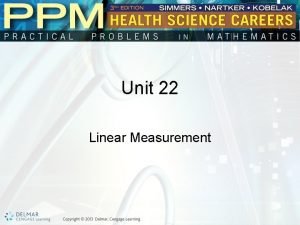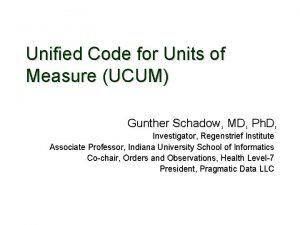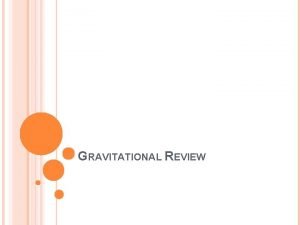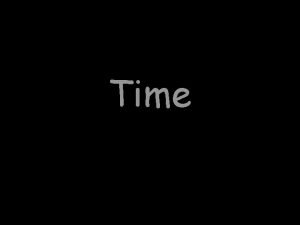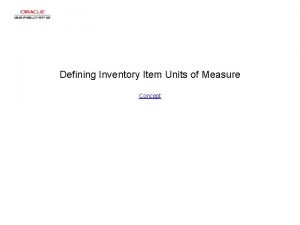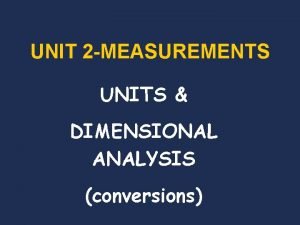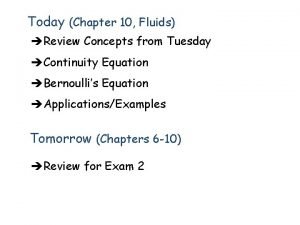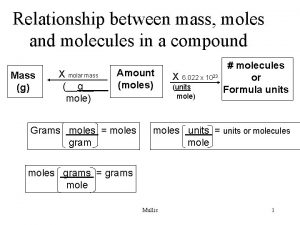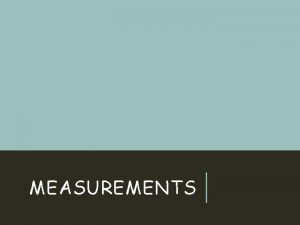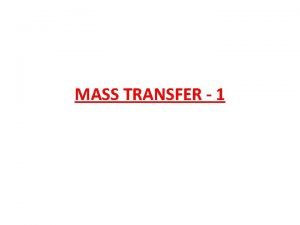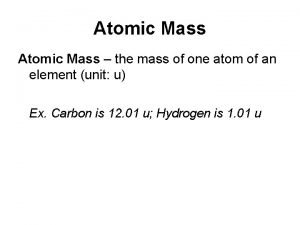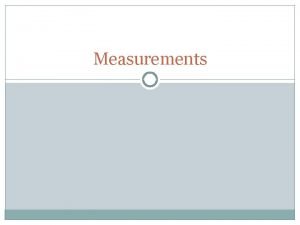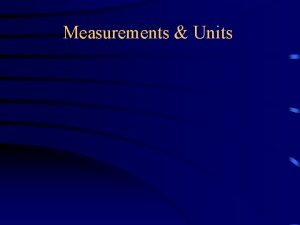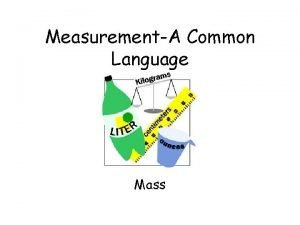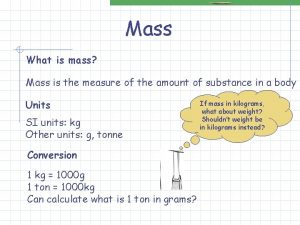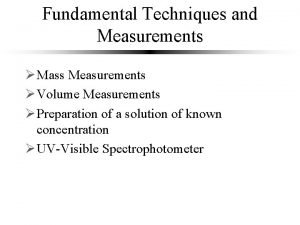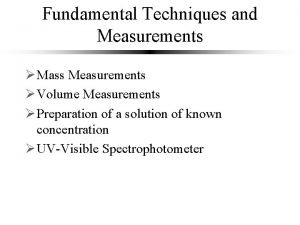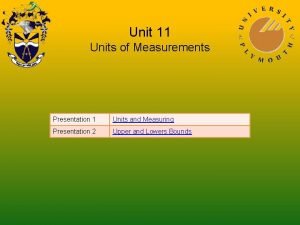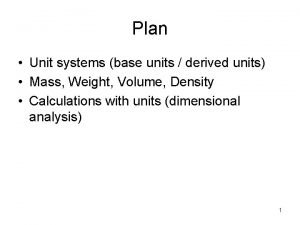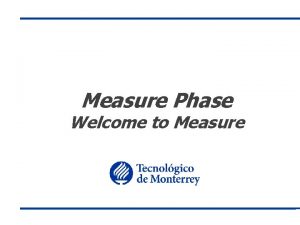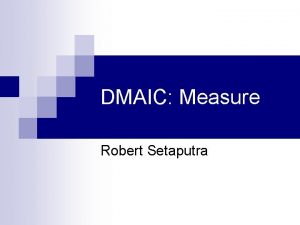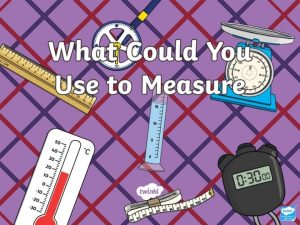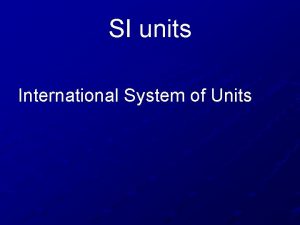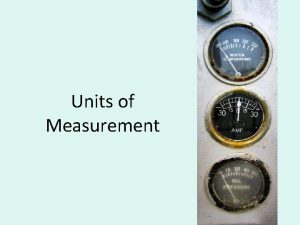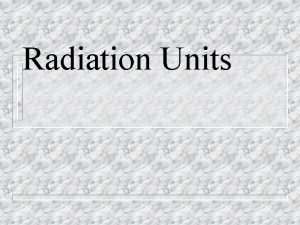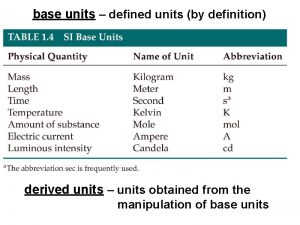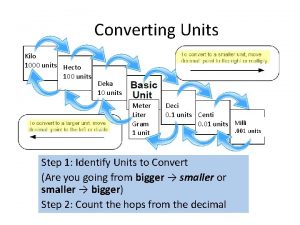MEASUREMENTS SI UNITS OF MEASURE SI Unit Mass




















- Slides: 20

MEASUREMENTS

SI UNITS OF MEASURE SI Unit Mass Length Volume Time Count Temperature Symbol kg m L sec mole Kelvin

READING MEASUREMENTS Always read one place past the graduation markings. This value is called an estimated digit.

METRIC CONVERSIONS M. . k h D b d c m. . μ. . n. . P King Henry Died by drinking chocolate milk

SCIENTIFIC NOTATION

WHY DO WE USE IT? To work with LARGE numbers like: 602, 000, 000, 000 To work with small numbers like: 0. 000 000 920 It’s easier (and less confusing) to put them in scientific notation

What does it look like? M x n 10 Ø“M” “n” isis the a numberbetween of decimal 1 and places 9. 9 Ø“M” moved CAN be a decimal (like 3. 2)

WHAT DO YOU MEAN… MOVE THE DECIMAL? ? ? If “n” is positive = BIG number 3. 0 x 104 “n” = 4 so you move the decimal 4 places to make the number BIG 30000.

If “n” is negative = small number 3. 0 x 10 -4 “n” = -4 so you move the decimal 4 places to make the number small. 0003

LET’S PRACTICE. . . 1) 7 x 103 = 2) 6. 8 x 106 = 3) 1. 356 x 10 -4 = 4) 7. 42 x 10 -3 = 7, 000 6, 800, 0001356. 00742

HOW ABOUT IN REVERSE? Can you change a number like 50, 000 into scientific notation?

FIRST Place a decimal in the number that would make it between 1 and 9. 9 In this case: 5. 0

SECOND Look at the original number: Is it big or small? ? ? If it’s LARGER than 1 positive “n” If it’s SMALLER than 1 negative “n”

LAST How many places did you move the decimal point? this will be your “n” The decimal moved from: 5. 0000 It moved 4 places, so the exponent is 4 5. 0 x 104

LET’S TRY THESE! 1) 2) 3) 6, 800, 000 6. 8 x 106 13, 430, 000 1. 343 x 107 0. 03459 3. 459 x 10 -2

Metric Conversions Ladder Method T. Trimpe 2008 http: //sciencespot. net/

Ladder Method 1 2 KILO 1000 Units HECTO 100 Units 3 DEKA 10 Units Meters Liters Grams DECI 0. 1 Unit How do you use the “ladder” method? 1 st – Determine your starting point and ending point. 2 nd – Count the “jumps” to your ending point. 3 rd – Move the decimal the same number of jumps in the same direction. CENTI 0. 01 Unit MILLI 0. 001 Unit 4 km = _____ m Starting Point Ending Point How many jumps does it take? 4. __. __. = 4000 m 1 2 3

Conversion Practice Try these conversions using the ladder method. 1000 mg = _______ g 1 L = _______ m. L 160 cm = _______ mm 14 km = _______ m 109 g = _______ kg 250 m = _______ km Compare using <, >, or =. 56 cm 6 m 7 g 698 mg

Metric Conversion Challenge Write the correct abbreviation for each metric unit. 1) Kilogram _____ 4) Milliliter _____ 7) Kilometer _____ 2) Meter _____ 5) Millimeter _____ 8) Centimeter _____ 3) Gram _____ 6) Liter _____ 9) Milligram _____ Try these conversions, using the ladder method. 10) 2000 mg = _______ g 15) 5 L = _______ m. L 20) 16 cm = _______ mm 11) 104 km = _______ m 16) 198 g = _______ kg 21) 2500 m = _______ km 12) 480 cm = _____ m 17) 75 m. L = _____ L 22) 65 g = _____ mg 13) 5. 6 kg = _____ g 18) 50 cm = _____ m 23) 6. 3 cm = _____ mm 14) 8 mm = _____ cm 19) 5. 6 m = _____ cm 24) 120 mg = _____ g

Compare using <, >, or =. 25) 63 cm 26) 536 cm 6 m 53. 6 dm 27) 5 g 28) 43 mg 508 mg 5 g 29) 1, 500 m. L 30) 3. 6 m 1. 5 L 36 cm
 Measured quantity
Measured quantity 3 units of linear measurements in metric system
3 units of linear measurements in metric system K
K When units manufactured exceed units sold:
When units manufactured exceed units sold: Ucum
Ucum The greatest gravitational force would occur between
The greatest gravitational force would occur between What units do we use to measure time
What units do we use to measure time Unit of measure concept
Unit of measure concept Gibbons jacobean city comedy download
Gibbons jacobean city comedy download What does a wind vane measure
What does a wind vane measure Dimensional analysis
Dimensional analysis Mass flow rate unit
Mass flow rate unit What are the units for molar mass
What are the units for molar mass Molar mass unit
Molar mass unit Si units mass
Si units mass Si unit to english unit
Si unit to english unit Modes of mass transfer
Modes of mass transfer The units of molar mass are
The units of molar mass are Atomicity example
Atomicity example Equimolar counter diffusion formula
Equimolar counter diffusion formula Unit of molar mass
Unit of molar mass

